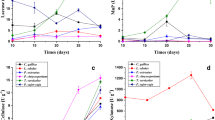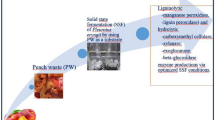Abstract
In current practice, oil palm frond leaflets and stems are re-used for soil nutrient recycling, while the petioles are typically burned. Frond petioles have high commercialization value, attributed to high lignocellulose fiber content and abundant of juice containing free reducing sugars. Pressed petiole fiber is the subject of interest in this study for the production of lignocellulolytic enzyme. The initial characterization showed the combination of 0.125 mm frond particle size and 60% moisture content provided a surface area of 42.3 m2/g, porosity of 12.8%, and density of 1.2 g/cm3, which facilitated fungal solid-state fermentation. Among the several species of Aspergillus and Trichoderma tested, Aspergillus awamori MMS4 yielded the highest xylanase (109 IU/g) and cellulase (12 IU/g), while Trichoderma virens UKM1 yielded the highest lignin peroxidase (222 IU/g). Crude enzyme cocktail also contained various sugar residues, mainly glucose and xylose (0.1–0.4 g/L), from the hydrolysis of cellulose and hemicellulose. FT-IR analysis of the fermented petioles observed reduction in cellulose crystallinity (I900/1098), cellulose–lignin (I900/1511), and lignin–hemicellulose (I1511/1738) linkages. The study demonstrated successful bioconversion of chemically untreated frond petioles into lignin peroxidase and xylanase-rich enzyme cocktail under SSF condition.






Similar content being viewed by others
References
Abalone R, Cassinera A, Gaston A, Lara M (2004) Some physical properties of amaranth seeds. Biosyst Eng 89(1):109–117
Abdel-Hamid AM, Solbiati JO, Cann IK (2013) Insights into lignin degradation and its potential industrial applications. In: Advances in Applied Microbiology, vol 82. Elsevier, pp 1–28
Abdul Khalil H, Siti Alwani M, Ridzuan R, Kamarudin H, Khairul A (2008) Chemical composition, morphological characteristics, and cell wall structure of Malaysian oil palm fibers. Polym Plast Technol Eng 47(3):273–280
Amorim GM, Oliveira AC, Gutarra ML, Godoy MG, Freire DM (2017) Solid-state fermentation as a tool for methylxanthine reduction and simultaneous xylanase production in cocoa meal. Biocatal Agric Biotechnol 11:34–41
Ang S, Shaza E, Adibah Y, Suraini A, Madihah M (2013) Production of cellulases and xylanase by Aspergillus fumigatus SK1 using untreated oil palm trunk through solid state fermentation. Process Biochem 48(9):1293–1302
Ang S, Yahya A, Abd Aziz S, Md Salleh M (2015) Isolation, screening, and identification of potential cellulolytic and xylanolytic producers for biodegradation of untreated oil palm trunk and its application in saccharification of lemongrass leaves. Prep Biochem Biotech 45(3):279–305
Bhargav S, Panda BP, Ali M, Javed S (2008) Solid-state fermentation: an overview. Chem Biochem Eng Q 22(1):49–70
Bhat M (2000) Cellulases and related enzymes in biotechnology. Biotechnol Adv 18(5):355–383
Bodirlau R, Teaca C (2009) Fourier transform infrared spectroscopy and thermal analysis of lignocellulose fillers treated with organic anhydrides. Rom J Phys 54(1–2):93–104
Cavalcante RS, Lima HL, Pinto GA, Gava CA, Rodrigues S (2008) Effect of moisture on Trichoderma conidia production on corn and wheat bran by solid state fermentation. Food Bioproc Tech 1(1):100–104
Chen H (2014) Research methods for the biotechnology of lignocellulose. Biotechnology of Lignocellulose. Springer, Dordrecht, pp 403–510
Corredor D, Salazar J, Hohn K, Bean S, Bean B, Wang D (2009) Evaluation and characterization of forage sorghum as feedstock for fermentable sugar production. Appl Biochem Biotechnol 158(1):164–179
Dahlan I (2000) Oil palm frond, a feed for herbivores. Asian-Australas J Anim Sci 13:300–303
Díaz AB, de Ory I, Caro I, Blandino A (2012) Enhance hydrolytic enzymes production by Aspergillus awamori on supplemented grape pomace. Food Bioprod Process 90(1):72–78
Ghose T (1987) Measurement of cellulase activities. Pure Appl Chem 59(2):257–268
Ghose T, Bisaria VS (1987) Measurement of hemicellulase activities: part I xylanases. Pure Appl Chem 59(12):1739–1751
Globe (2005) Soil particle density protocol. https://www.globe.gov. Accessed 25 Jan 2017
Goswami DY, Kreith F (2007) Energy conversion. CRC Press, Boca Roton, pp 3–14
Gottschalk LMF, Paredes RDS, Teixeira RSS, Silva ASAD., Bon EPDS. (2013) Efficient production of lignocellulolytic enzymes xylanase, β-xylosidase, ferulic acid esterase and β-glucosidase by the mutant strain Aspergillus awamori 2B. 361 U2/1. Braz J Microbiol 44(2):569–576
Ishida M, Abu Hassan O (1997) Utilization of oil palm frond as cattle feed. Jpn Agric Res Q 31(1):41–47
Islam M, Dahlan I, Rajion M, Jelan Z (2000) Productivity and nutritive values of different fractions of oil palm (Elaeis guineensis) frond. Asian-Australas J Anim Sci 13(8):1113–1120
Jahromi M, Liang J, Rosfarizan M, Goh YM, Shokryazdan P, Ho Y (2011) Efficiency of rice straw lignocelluloses degradability by Aspergillus terreus ATCC 74135 in solid state fermentation. Afr J Biotechnol 10(21):4428–4435
Karp SG, Faraco V, Amore A, Birolo L, Giangrande C, Soccol VT, Pandey A, Soccol CR (2012) Characterization of laccase isoforms produced by Pleurotus ostreatus in solid state fermentation of sugarcane bagasse. Bioresour Technol 114:735–739
Kaya F, Heitmann JA, Joyce TW (2000) Influence of lignin and its degradation products on enzymatic hydrolysis of xylan. J Biotechnol 80(3):241–247
Kline LM, Hayes DG, Womac AR, Labbe N (2010) Simplified determination of lignin content in hard and soft woods via UV-spectrophotometric analysis of biomass dissolved in ionic liquids. BioRes 5(3):1366–1383
Kredics L, Antal Z, Manczinger L, Szekeres A, Kevei F, Nagy E (2003) Influence of environmental parameters on Trichoderma strains with biocontrol potential. Food Technol Biotechnol 41(1):37–42
Krijgsheld P, Bleichrodt Rv, Van Veluw G, Wang F, Müller W, Dijksterhuis J, Wösten H (2013) Development in Aspergillus. Stud Mycol 74:1–29
Lai L-W, Idris A (2013) Disruption of oil palm trunks and fronds by microwave-alkali pretreatment. BioRes 8(2):2792–2804
Lee KC, Arai T, Ibrahim D, Deng L, Murata Y, Mori Y, Kosugi A (2016) Characterization of oil-palm trunk residue degradation enzymes derived from the isolated fungus, Penicillium rolfsii c3-2 (1) IBRL. Environ Technol 37(12):1550–1558
Mandels M, Weber J (1969) The production of cellulases. Adv Chem Ser 95:391–414
Manpreet S, Sawraj S, Sachin D, Pankaj S, Banerjee U (2005) Influence of process parameters on the production of metabolites in solid-state fermentation. Malays J Microbiol 2(1):1–9
Mansour AA, Arnaud T, Lu-Chau TA, Fdz-Polanco M, Moreira MT, Rivero JAC (2016) Review of solid state fermentation for lignocellulolytic enzyme production: challenges for environmental applications. Rev Environ Sci Biotechnol 15(1):31–46
Miller GL (1959) Use of dinitrosalicylic acid reagent for determination of reducing sugar. Anal Chem 31(3):426–428
Mitchell DA, von Meien OF, Krieger N, Dalsenter FDH (2004) A review of recent developments in modeling of microbial growth kinetics and intraparticle phenomena in solid-state fermentation. Biochem Eng J 17(1):15–26
Musa H, Han PC, Kasim FH, Gopinath SC, Ahmad MA (2017) Turning oil palm empty fruit bunch waste into substrate for optimal lipase secretion on solid state fermentation by Trichoderma strains. Process Biochem 63:35–41
Noratiqah K, Madihah M, Aisyah BS, Eva MS, Suraini A, Kamarulzaman K (2013) Statistical optimization of enzymatic degradation process for oil palm empty fruit bunch (OPEFB) in rotary drum bioreactor using crude cellulase produced from Aspergillus niger EFB1. Biochem Eng J 75:8–20
Öhgren K, Bengtsson O, Gorwa-Grauslund MF, Galbe M, Hahn-Hägerdal B, Zacchi G (2006) Simultaneous saccharification and co-fermentation of glucose and xylose in steam-pretreated corn stover at high fiber content with Saccharomyces cerevisiae TMB3400. J Biotechnol 126(4):488–498
Oliva-Taravilla A, Tomás-Pejó E, Demuez M, González-Fernández C, Ballesteros M (2015) Inhibition of cellulose enzymatic hydrolysis by laccase-derived compounds from phenols. Biotechnol Prog 31(3):700–706
Pandey A (2003) Solid-state fermentation. Biochem Eng J 13(2–3):81–84
Pfost H, Headley V (1976) Methods of determining and expressing particle size. In: Pfost H (ed) Feed manufacturing technology, vol 2. American Feed Manufacturers Association, Arlington, pp 512–520
Rosgaard L, Pedersen S, Cherry JR, Harris P, Meyer AS (2006) Efficiency of new fungal cellulase systems in boosting enzymatic degradation of barley straw lignocellulose. Biotechnol Prog 22(2):493–498
Roslan AM, Zahari MAKM., Hassan MA, Shirai Y (2014) Investigation of oil palm frond properties for use as biomaterials and biofuels. Trop Agric Dev 58(1):26–29
Rozali NL, Yarmo MA, Idris AS, Kushairi A, Ramli US (2017) Metabolomics differentiation of oil palm (‘Elaeis guineensis’ Jacq.) spear leaf with contrasting susceptibility to’Ganoderma boninense’. Plant Omics 10(2):45
Sakurai Y, Lee TH, Shiota H (1977) On the convenient method for glucosamine estimation in koji. Agric Biol Chem 41(4):619–624
Satyanarayana T, Johri BN (2005) Microbial diversity: current perspectives and potential applications. I.K. International, New Delhi, p 821
Sharma S, Sharma V, Kuila A (2016) Cellulase production using natural medium and its application on enzymatic hydrolysis of thermo chemically pretreated biomass. 3 Biotech 6(2):1–11
Singh A, Shahid M, Srivastava M, Pandey S, Sharma A, Kumar V (2014) Optimal physical parameters for growth of Trichoderma species at varying pH, temperature and agitation. Virol Mycol 3(1):1–7
Singh R, Kumar M, Mittal A, Mehta PK (2016) Microbial enzymes: industrial progress in 21st century. 3 Biotech 6(2):174
Singhania RR, Sukumaran RK, Patel AK, Larroche C, Pandey A (2010) Advancement and comparative profiles in the production technologies using solid-state and submerged fermentation for microbial cellulases. Enzyme Microb Technol 46(7):541–549
Sorek N, Yeats TH, Szemenyei H, Youngs H, Somerville CR (2014) The implications of lignocellulosic biomass chemical composition for the production of advanced biofuels. Bioscience 64(3):192–201
Sukiran MA, Abnisa F, Daud WMAW., Bakar NA, Loh SK (2017) A review of torrefaction of oil palm solid wastes for biofuel production. Energy Convers Manag 149:101–120
Tan JP, Jahim JM, Harun S, Wu TY (2017) Overview of the potential of bio-succinic acid production from oil palm fronds. J Phys Sci 28:53
Tien M (1988) Lignin peroxidase of Phanerochaete chrysosporium. Methods Enzymol 161:238–299
Vikineswary S, Abdullah N, Renuvathani M, Sekaran M, Pandey A, Jones E (2006) Productivity of laccase in solid substrate fermentation of selected agro-residues by Pycnoporus sanguineus. Bioresour Technol 97(1):171–177
Yang X, Wang J, Zhao X, Wang Q, Xue R (2011) Increasing manganese peroxidase production and biodecolorization of triphenylmethane dyes by novel fungal consortium. Bioresour Technol 102(22):10535–10541
Yoon LW, Ang TN, Ngoh GC, Chua ASM (2014) Fungal solid-state fermentation and various methods of enhancement in cellulase production. Biomass Bioenergy 67:319–338
Yuliansyah AT, Hirajima T (2012) Efficacy of hydrothermal treatment for production of solid fuel from oil palm wastes. Resource management for sustainable agriculture. Intech, London
Yunus R, Salleh SF, Abdullah N, Biak DRA (2010) Effect of ultrasonic pre-treatment on low temperature acid hydrolysis of oil palm empty fruit bunch. Bioresour Technol 101(24):9792–9796
Zahari MAKM., Zakaria MR, Ariffin H, Mokhtar MN, Salihon J, Shirai Y, Hassan MA (2012) Renewable sugars from oil palm frond juice as an alternative novel fermentation feedstock for value-added products. Bioresour Technol 110:566–571
Zambare V (2010) Solid state fermentation of Aspergillus oryzae for glucoamylase production on agro residues. Int J Life Sci Res 4:16–25
Zhou S, Raouche S, Grisel S, Navarro D, Sigoillot JC, Herpoël-Gimbert I (2015) Solid-state fermentation in multi-well plates to assess pretreatment efficiency of rot fungi on lignocellulose biomass. Microb Biotechnol 8(6):940–949
Acknowledgements
This work was financially supported by Research University Grant (Q.J130000.2545.10H48) of Universiti Teknologi Malaysia (UTM) and MyBrain15—Ministry of Higher Education Malaysia (MOHE). We thankfully acknowledge the valuable comments and suggestions of Professor Suraini Abdul Aziz (Universiti Putra Malaysia) and all members of the Environmental Biotechnology Research Group (EnVBiotech), as well as Resource Sustainability (Research Alliance), and the Faculty of Biosciences and Medical Engineering of UTM for their continuous support.
Author information
Authors and Affiliations
Corresponding author
Ethics declarations
Conflict of interest
On behalf of all authors, the corresponding author states that there is no conflict of interest.
Rights and permissions
About this article
Cite this article
Mohamad Ikubar, M.R., Abdul Manan, M., Md. Salleh, M. et al. Solid-state fermentation of oil palm frond petiole for lignin peroxidase and xylanase-rich cocktail production. 3 Biotech 8, 259 (2018). https://doi.org/10.1007/s13205-018-1268-1
Received:
Accepted:
Published:
DOI: https://doi.org/10.1007/s13205-018-1268-1




